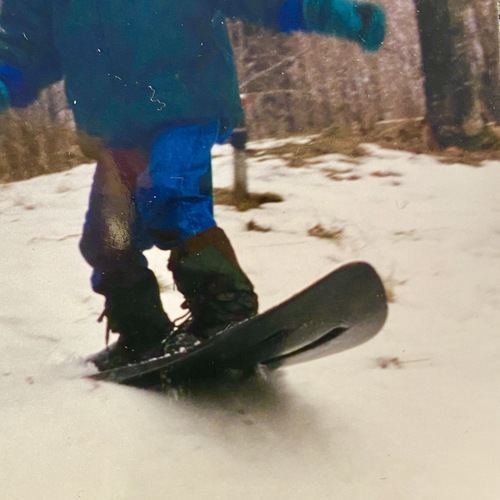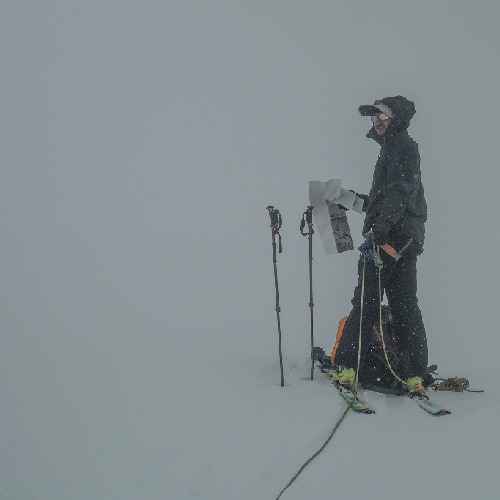- Posts: 913
- Thank you received: 1
A model for inter-party avalanche involvements
- Charlie Hagedorn
- [trumpetsailor]
-
 Topic Author
Topic Author
- Offline
- Elite Member
-

Less
More
19 Dec 2019 09:17 #166142
by Charlie Hagedorn
A model for inter-party avalanche involvements was created by Charlie Hagedorn
It is December 19, so it seems like an appropriate day to let TAY know about a paper that was catalyzed by the December 19, 2015 Kendall Peak incident. I must stress that I am not taking a position on the events of December 19, 2015 with this work -- that it was even possible that the incident was inter-party was sufficient to get this work off the ground. This work is intended for professionals and experts, but as the work began locally, it makes sense to chat about it locally, too.
The paper builds a first-principles model for inter-party avalanche involvements and compares it with known-and-possible interparty events in North America. The model and the historical record turn out to be in qualitative agreement.
The model predicts that the likelihood of inter-party avalanche involvements grows like the number of parties per unit area squared and that the primary factor that determines the relative likelihood of inter-party involvements to single-party involvements is the size of a given day's avalanches. As a rule of thumb, inter-party avalanches have happened when the density of parties was greater than roughly one party per twenty avalanche-areas.
The paper can be found on the arXiv or via KendallPeak.org . A summary article can also be found in this month's issue of The Avalanche Review.
Like clockwork, a big snowfall event is on tap for the first real weekend of winter backcountry skiing in the Cascades. As in 2015, everyone is hungry for powder. Please take care not just to keep your party out of trouble, but also to be aware of parties above and below you. It matters.
The paper builds a first-principles model for inter-party avalanche involvements and compares it with known-and-possible interparty events in North America. The model and the historical record turn out to be in qualitative agreement.
The model predicts that the likelihood of inter-party avalanche involvements grows like the number of parties per unit area squared and that the primary factor that determines the relative likelihood of inter-party involvements to single-party involvements is the size of a given day's avalanches. As a rule of thumb, inter-party avalanches have happened when the density of parties was greater than roughly one party per twenty avalanche-areas.
The paper can be found on the arXiv or via KendallPeak.org . A summary article can also be found in this month's issue of The Avalanche Review.
Like clockwork, a big snowfall event is on tap for the first real weekend of winter backcountry skiing in the Cascades. As in 2015, everyone is hungry for powder. Please take care not just to keep your party out of trouble, but also to be aware of parties above and below you. It matters.
Please Log in or Create an account to join the conversation.
- kamtron
- [kamtron]
-

- Offline
- Senior Member
-

Less
More
- Posts: 269
- Thank you received: 8
19 Dec 2019 18:04 #166150
by kamtron
Replied by kamtron on topic Re: A model for inter-party avalanche involvements
Interesting, Charlie. I will have to give it a full read (haven't yet). But a quadratic rate would make sense from mass-action well-mixed assumptions, similar to models used in chemistry and ecology.
My guess is that above some density, people tend to avoid each other, so there could be a mollifying effect of that. Maybe modeled by a sigmoid of some kind makes sense. Of course, any empirical data is going to be sparse.
Did you submit the full article for publication? I couldn't find the Avalanche Review version online.
My guess is that above some density, people tend to avoid each other, so there could be a mollifying effect of that. Maybe modeled by a sigmoid of some kind makes sense. Of course, any empirical data is going to be sparse.
Did you submit the full article for publication? I couldn't find the Avalanche Review version online.
Please Log in or Create an account to join the conversation.
- Charlie Hagedorn
- [trumpetsailor]
-
 Topic Author
Topic Author
- Offline
- Elite Member
-

Less
More
- Posts: 913
- Thank you received: 1
20 Dec 2019 07:53 - 20 Dec 2019 08:09 #166152
by Charlie Hagedorn
Replied by Charlie Hagedorn on topic Re: A model for inter-party avalanche involvements
I would have submitted it to a journal if the journals I dug up hadn't had kilobuck-scale page charges and restrictive copyright requirements, some requiring pre-publication embargoes. I want the thing to be read, it is timely, and it isn't in my career path, so arXiv it is. The embargoes are particularly grating; we don't do anything like that in physics -- nobody would submit to a journal that blocked arXiv preprints. If the paper continues to get traction, I may submit it to ISSW2020. The paper is intended to catalyze a professional conversation; if it can do that (and it seems to be doing so), it has done its job.
TAR makes articles free-to-read after a year -- the TAR article is the movie-trailer for the larger paper. The message is the same (but the TAR layout and spirit are more-approachable).
Agreed that, in some contexts, people avoid high densities. In constrained terrain, however, people are willing to accept remarkably high densities. Put two or three parties in the Slot simultaneously, and you have densities of 200-400 parties/km^2.
There is one big chance to expand on the statistical dataset: Europe. They're generally operating at much higher densities, and there are long historical records. I'm hopeful that someone over there with a reasonable knowledge of historical accidents decides to take a look.
TAR makes articles free-to-read after a year -- the TAR article is the movie-trailer for the larger paper. The message is the same (but the TAR layout and spirit are more-approachable).
Agreed that, in some contexts, people avoid high densities. In constrained terrain, however, people are willing to accept remarkably high densities. Put two or three parties in the Slot simultaneously, and you have densities of 200-400 parties/km^2.
There is one big chance to expand on the statistical dataset: Europe. They're generally operating at much higher densities, and there are long historical records. I'm hopeful that someone over there with a reasonable knowledge of historical accidents decides to take a look.
Last edit: 20 Dec 2019 08:09 by Charlie Hagedorn.
Please Log in or Create an account to join the conversation.
- Skier of the Hood
- [Skier of the Hood]
-

- Offline
- New Member
-

Less
More
- Posts: 38
- Thank you received: 3
20 Dec 2019 12:41 - 20 Dec 2019 12:51 #166154
by Skier of the Hood
Replied by Skier of the Hood on topic Re: A model for inter-party avalanche involvements
Edit: Quick glance reveals you have been much more thorough then I assumed and actually have identified the incident I linked below in the article. Perhaps you should consider reaching out to Dr. Pascal at SFU. I'sure if you made him a coauthor he could get you all the Canadian data you so desire (;
www.sfu.ca/rem/people/profiles/haegeli.html
Will read the article when I get home, but first thought is to take a look at Rogers Pass and the Icefields Parkway in Canada. Very high densities of people amongst much larger terrain then is available from trailheads in Washington. One prominent example is linked below, but I know there are more, and avalanche Canada would have the statistics at least as far as fatalities go. furthermore for Rogers pass they tally daily skier visits, and you may even be able to narrow it down to specific permit areas, such as avalanche crest where the incident occurred below. Parks Canada seems to be willing to share skier visit data at least as of a few years ago.
biglines.com/conditions/avalanche/rogers...2016-dan-michalchuk/
www.sfu.ca/rem/people/profiles/haegeli.html
Will read the article when I get home, but first thought is to take a look at Rogers Pass and the Icefields Parkway in Canada. Very high densities of people amongst much larger terrain then is available from trailheads in Washington. One prominent example is linked below, but I know there are more, and avalanche Canada would have the statistics at least as far as fatalities go. furthermore for Rogers pass they tally daily skier visits, and you may even be able to narrow it down to specific permit areas, such as avalanche crest where the incident occurred below. Parks Canada seems to be willing to share skier visit data at least as of a few years ago.
biglines.com/conditions/avalanche/rogers...2016-dan-michalchuk/
Last edit: 20 Dec 2019 12:51 by Skier of the Hood.
Please Log in or Create an account to join the conversation.
- Charlie Hagedorn
- [trumpetsailor]
-
 Topic Author
Topic Author
- Offline
- Elite Member
-

Less
More
- Posts: 913
- Thank you received: 1
20 Dec 2019 17:26 #166157
by Charlie Hagedorn
Replied by Charlie Hagedorn on topic Re: A model for inter-party avalanche involvements
I looked for a long time for good modern Canadian accident reports. Canada appears to have a different approach to online reporting -- much more terse. This may be due to a different legal/political environment, I'm not sure. I've been in contact with Avalanche Canada about link-rot in their online database; they're people-power starved and will address it when they can.
The Canadian compendia, on the other hand, are remarkable. Avalanche Accidents in Canada Vol. 5 is a masterwork. It is my understanding that Haegeli is among the authors again for Volume 6. I reached out to him, but did not get a reply -- as I know from my own work, academics can't always respond to every request for assistance. Bruce Jamieson was extremely helpful in both suggesting accidents of which I was unaware and in critiquing the work in general.
The stage is set for people with larger accident databases to test the model. I'm not planning to carry this work much deeper than this, but I would love to support those who might.
The Canadian compendia, on the other hand, are remarkable. Avalanche Accidents in Canada Vol. 5 is a masterwork. It is my understanding that Haegeli is among the authors again for Volume 6. I reached out to him, but did not get a reply -- as I know from my own work, academics can't always respond to every request for assistance. Bruce Jamieson was extremely helpful in both suggesting accidents of which I was unaware and in critiquing the work in general.
The stage is set for people with larger accident databases to test the model. I'm not planning to carry this work much deeper than this, but I would love to support those who might.
Please Log in or Create an account to join the conversation.
